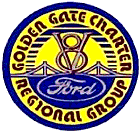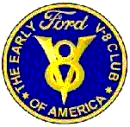 |
Early Ford V-8 Club of America Golden Gate Charter Regional Group #1 |
 |
Chevy Small Block: Ford origin rumor confirmed
In these days of uncertainty as to the viability of the American Auto manufacturers, FoMoCo has at last confirmed the 56-year-old rumor of arguably the biggest, most successful case of industrial espionage of the 20th century. Born of a decades old bitter rivalry between Ford and Chevrolet, the blatant act of piracy had remained unconfirmed until the present day to the delight of General Motors. The big secret? None other than the Ford Motor Company origin of the Chevrolet 265 cid Small Block.
This story goes back to the final days of WWII, when Auto manufacturers were anticipating release from Uncle Sam to resume production of cars and trucks for the Civilian population. The Big Three were at the starting gates with their warmed over prewar models, hoping to score big with the pent up demand for shiny new cars. Ford jumped the gun and was first to market, but with nothing new to offer. In Engineering, and to a lesser degree Style, Ford was lacking in pizzazz, so after the initial demand was satisfied, Ford began to drop behind the competition and slip badly in sales.
Ford would come to realize that the engine that had faithfully served since its introduction in 1932 had just about run its course. The L Head Engine was not going to power the new generation of Fords. Along came Zora Arkus-Duntov, who courted Ford with an aftermarket OHV package that adapted the venerable old Ford engine to the modern world. The year was 1947, and modified Ford engines, always popular on the farm, in the city, and in the Blue Ridge world of Moonshiners, were now to be big news on the modern trucking scene with this high dollar big horsepower Ford engine conversion.
Well, no dice. Ford had been known as an innovative company, and would not view the off-site creation with favor. Zora’s conversion, which he named Ardun, a contraction of his hyphenated name Arkus-Duntov, was also up to his ears in lawsuits from Chrysler Corporation for the design of his hemispherical combustion chamber. Chrysler had patents pending on an engine in development at the time, having opposing valve characteristics identical to the Ardun, even though BMW had a similar design in the 1930’s. Investors in Arkus-Duntov’s project slinked away into the shadows, leaving Zora with a mere 400 copies of the Ardun conversion package.
Ford, now also left in the lurch, was running out of time for an engineering breakthrough, as General Motors was about to launch V8s, the Oldsmobile to be first to hit the street the following year. Ford decided to go with fresh styling for 1949. This was an excellent decision, as it put Ford out front with slab styling, not available from General Motors. Temporarily back in the drivers seat with styling, Ford went forward with the design of two brand new engines: The first, a big block OHV engine to replace its 237 cubic inch monster in Lincoln automobiles and Fords big trucks.
For the successor to the Ford/Mercury Flathead, a new Small Block OHV engine would be developed. Initial complications slowed the progress of the small block, so Zora Arkus Duntov was discretely brought aboard as consultant. Zora was himself kept at arms length by Ford on a need to know basis, and would be paid as an independent consultant, as Chevrolet’s spy network was known to be more extensive than Ford’s own.
As reported by Ford engineers at the time, the secrecy and lack of status afforded Zora accentuated a lack of communication first seen back when Ford had snubbed him and his adaptation for the flat motor. However, with Zora on board as consultant, a new engine was eventually developed, and it was a good one. The basics were very similar to the old flathead, but with this new design, it was now an overhead valve engine, having a shorter stroke and bigger bore. It was otherwise similar in size, weight, and engineering, right down to the 2 bolt main bearings and bypass oil system, and importantly, it was a dead on slam dunk for direct replacement of the flathead at whatever point Ford decided to put it into production
Arkus-Duntov having been but a consultant, he was now dismissed and out of the picture. Fords new small engine had taken longer to develop than the big block, which would come to be known as the Y block, but was now scheduled to be introduced with a full 160 horsepower, and that from a Ford Holley two-barrel carburetor. This little honey of an engine would be the driving force in Ford’s recapture of the automobile market, with tentative release for full production expected to come in time for the 1955 model year. Then something happened that set Ford back on its heels.
News leaked from industry sources that Chevrolet’s Chief Engineer Ed Cole, in conjunction with Chevrolet Staff Engineer Zora Arkus-Duntov, had developed a sweet little engine slated for release in 1955. It would have a short 3” stroke, a full 3 ¾ “ bore, and 162 horsepower, and would initially be equipped with a simple two-barrel carburetor. Henry Ford II was livid. The next production year was 1954, and he knew he’d soon be outclassed by Chevy with an engine that was engineered by Ford
Some hard choices were to be made. If a court challenge were made, it would hurt both automakers. Fords lawyers were anything but certain of the outcome, and the engine would be in neither car until the case was settled. The decision to drop Ford’s OHV Small Block was made on April 1, 1953. The industrial strength Lincoln Y Block, now in service for almost two years, would be immediately adapted to become 1954’s Job One for the American Ford/Mercury production, trumping Chevrolet’s Small Block V8 by a full year. All remaining inventory of flathead motors was to be relegated to Ford of Canada. There would be no lawsuit filed against Chevrolet.
This chapter of the rivalry between Ford and Chevrolet is now documented history as of April 1 of this year, available and online for public viewing. Several amazing photographs with substantiating documents and design specifications of the Ford and later the Chevrolet versions of the now famous Chevrolet Small Block are now available for comparison. For this and additional information on Chevrolet - Ford espionage, see the following website: springcourt.info/ford/chevrolet/espionage/